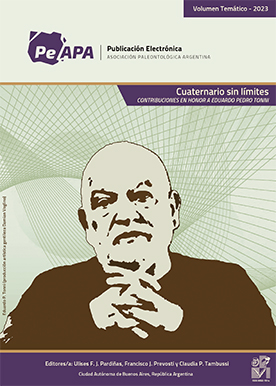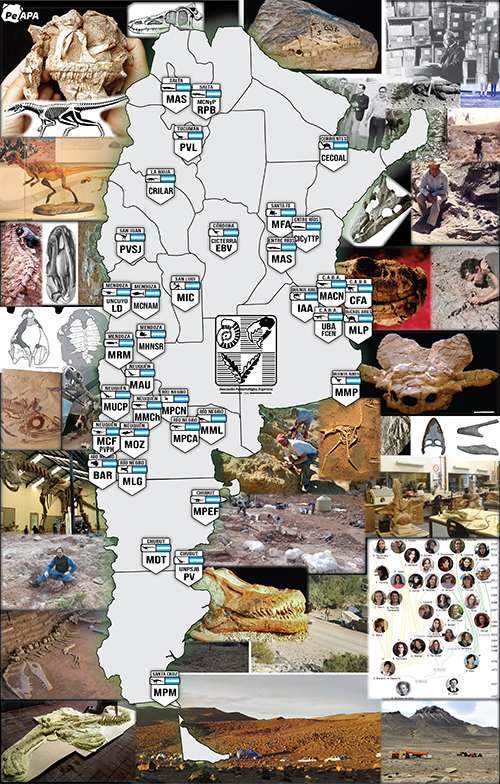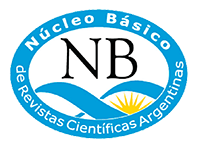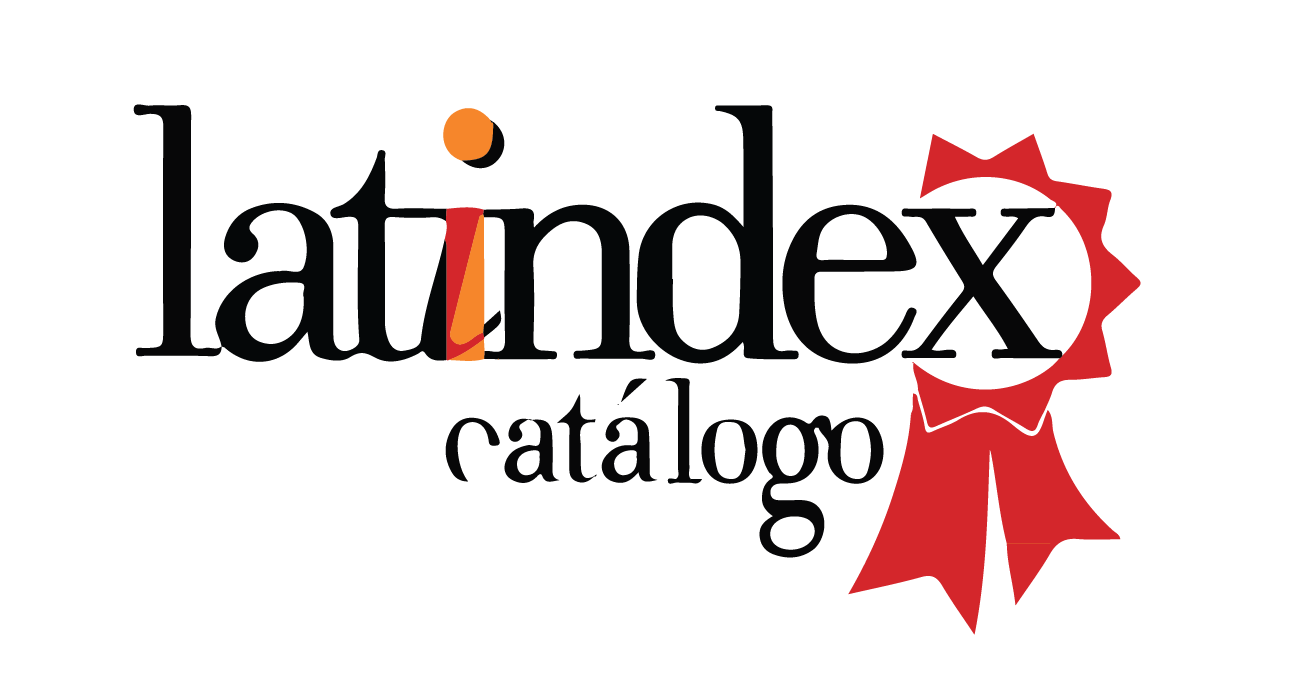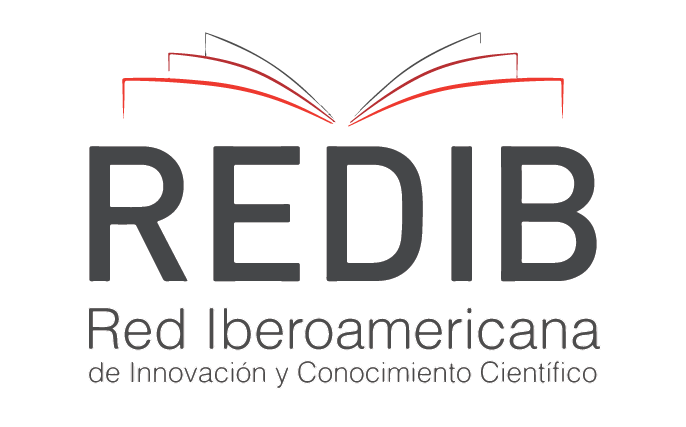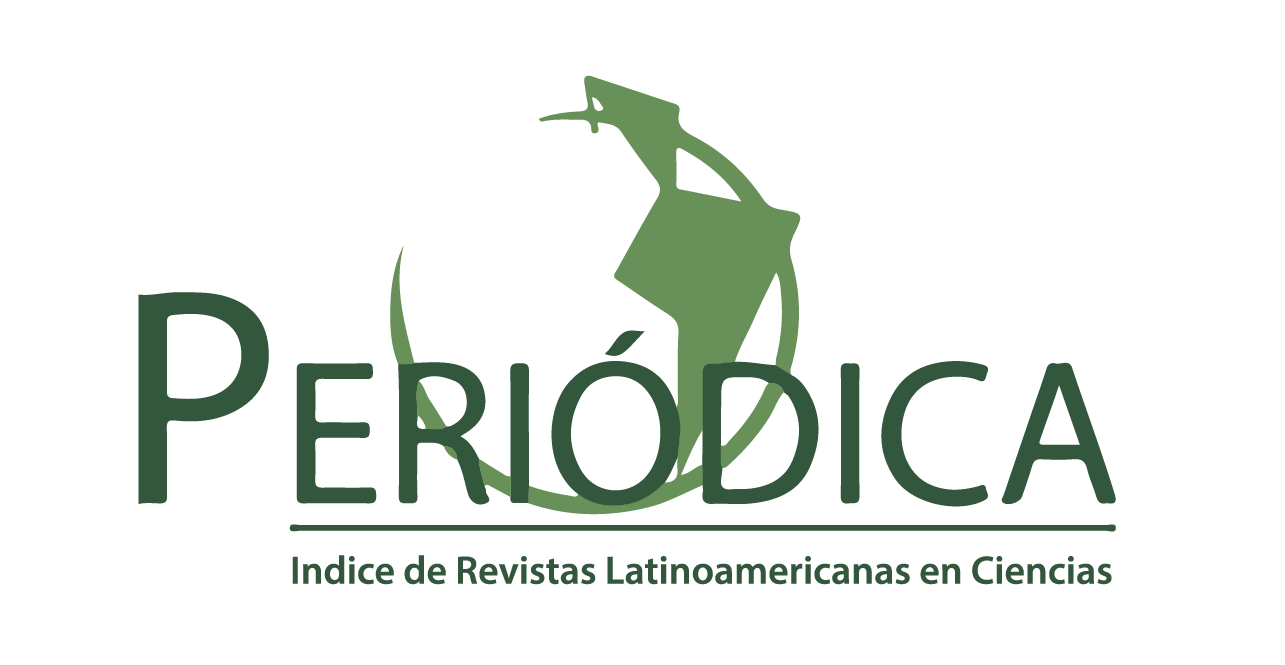NOTOUNGULATA Y ASTRAPOTHERIA (MAMMALIA, MERIDIUNGULATA) DE LA FORMACION SANTA CRUZ (MIOCENO TEMPRANO– MEDIO) A LO LARGO DEL RÍO SANTA CRUZ, PATAGONIA ARGENTINA
DOI:
https://doi.org/10.5710/PEAPA.19.09.2019.288Palabras clave:
Notoungulados, Astrapoterios, Typotheria, Toxodontia, Ameghino, SantacrucenseResumen
Esta contribución involucra un reporte faunístico de los nuevos registros de Notoungulata y Astrapotheria provenientes de los yacimientos de la Formación Santa Cruz del Río Santa Cruz (Mioceno Temprano–Medio; provincia de Santa Cruz). El astrapoterio Astrapotherium sp., los notoungulados toxodontes Homalodotherium sp. Flower, Nesodon sp. Owen y Adinotherium sp. Ameghino, y los tipoterios Hegetotherium mirabile Ameghino, Interatherium sp. Ameghino, Protypotherium sp. Ameghino, P. attenuatum Ameghino, P. australe Ameghino y P. praerutilum Ameghino fueron reconocidos en Barrancas Blancas y Segunda Barrancas Blancas. Las especies Nesodon imbricatus Owen y Adinotherium ovinum (Owen) fueron identificados en la primera y en la segunda localidad, respectiva- mente. El tipoterio Pachyrukhos moyani Ameghino fue identificado únicamente en Segundas Barrancas Blancas, pero a través de numerosos ejemplares. Solo los ungulados de gran talla Astrapotherium magnum (Owen) y Adinotherium sp. fueron reconocidos en Yaten Huageno. A un nivel supraespecífico, Barrancas Blancas y Segundas Barrancas Blancas difieren por la presencia de Pachyrukhos Ameghino en la segunda, mien- tras que en Yaten Huageno los Typotheria, Homalodotheriidae y Nesodon no han sido identificados. La composición faunística general, incluyendo las grandes muestras provenientes de Barrancas Blancas y Segundas Barrancas Blancas, coincide con la registrada en las localidades Santacrucenses más conocidas de la costa Atlántica. Esta similitud faunística permite inferir, preliminarmente, similares condiciones ambien- tales, indicando que las localidades del Río Santa Cruz podrían haber constituido un complejo mosaico de ambientes abiertos y cerrados.
Citas
Ameghino, C. 1890. Exploraciones geológicas en la Patagonia. Boletín del Instituto Geográfico Argentino 11: 3–46.
Ameghino, F. 1882. Catálogo explicativo de las colecciones de Antropología prehistórica y de paleontología de Florentino Ameghino, Partido de Mercedes. In C.Urioste, T. Ambrosetti, B. Butteler, R.A. de Toledo, F. Ruiz, M. Lainez, E. Schröder, H. Quesada, M. Duggan, and R.C. Araujo Muñoz (Eds.), Catálogo de la Sección de la provincia de Buenos Aires (República Argentina), en la Exposición Continental Sudamericana. Anexo A, Buenos Aires, p. 35–42.
Ameghino, F. 1885. Nuevos restos de mamíferos fósiles oligocenos, recogidos por el profesor Pedro Scalabrini y pertenecientes al Museo Provincial de la Ciudad del Paraná. Boletín de la Academia Nacional de Ciencias de Córdoba 8: 5–207.
Ameghino, F. 1887a. Observaciones generales sobre el orden de mamíferos extinguidos sub-americanos llamados Toxodontes (Toxodontia) y sinopsis de los géneros y especies hasta ahora conocidos. Anales del Museo de La Plata 1: 1–66.
Ameghino, F. 1887b. Enumeración sistemática de las especies de mamíferos fósiles coleccionados por Carlos Ameghino en los terrenos eocenos de la Patagonia austral y depositados en el Museo La Plata. Boletín del Museo de La Plata 1: 1–26.
Ameghino, F. 1889. Contribución al conocimiento de los mamíferos fósiles de la República Argentina. Actas de la Academia Nacional de Ciencias de Córdoba, 6: i–xxxii, 1–1027, atlas of 98 pls.
Ameghino, F. 1891a. Nuevos restos de mamíferos fósiles descubiertos por Carlos Ameghino en el Eoceno inferior de la Patagonia Austral. Especies nuevas, adiciones y correcciones. Revista Argentina de Historia Natural 1: 286–328.
Ameghino, F. 1891b. Observaciones críticas sobre los mamíferos eocenos de la Patagonia austral. Revista Argentina de Historia Natural 1: 328–382.
Ameghino, F. 1891c. Caracteres diagnósticos de cincuenta especies nuevas de mamíferos fósiles argentinos. Revista Argentina de Historia Natural 1:129–167.
Ameghino, F. 1894. Énumération synoptique des espèces de mammifères fossiles des formations éocènes de Patagonie. Coni é hijos, Buenos Aires, 196 p.
Ameghino, F. 1900–1902. L'âge des formations sédimentaires de Patagonie. Anales de la Sociedad Científica Argentina. 50 (1900)–51–52 (1901)–54 (1902): 109–130; 145–165; 209–229 /120–139; 165–191 /189–197; 244–250 / 161–180; 220–249; 283–342.
Ameghino, F. 1907. Les toxodontes a’cornes. Anales del Museo Nacional de Historia Natural de Buenos Aires 16: 49–91.
Billet, G. 2010. New observations on the skull of Pyrotherium (Pyrotheria, Mammalia) and new phylogenetic hypotheses on South American ungulates. Journal of Mammalian Evolution 17: 21–59.
Billet, G. 2011. Phylogeny of the Notoungulata (Mammalia) based on cranial and dental characters. Journal of Systematic Palaeontology 9: 481–497.
Billet, G., De Muizon, C., and Mamani Quispe, B. 2008. Late Oligocene mesotheriids (Mammalia, Notoungulata) from Salla and Lacayani (Bolivia): implications for basal mesotheriid phylogeny and distribution. Zoological Journal of the Linnean Society 152: 153–200.
Billet, G., De Muizon, C., Schellhorn, R., Ruf, I., Ladevèze, S., and Bergqvist, L. 2015. Petrosal and inner ear anatomy and allometry amongst specimens referred to Litopterna (Placentalia). Zoological Journal of the Linnean Society 173: 956–987.
Bond, M. 1986. Los ungulados fósiles de Argentina: evolución y paleoambientes. Simposio "Evolución de los Vertebrados Cenozoicos", IV Congreso Argentino de Paleontología y Bioestratigrafía Actas 2: 187–190.
Bond, M. 1999. Quaternary native ungulates of Southern South America. A synthesis. In J. Rabassa, and M. Salemme (Eds.), Quaternary of South America and Antarctic Peninsula, Ushuaia, Tierra de Fuego: Centro Austral de Investigaciones Científicas and Universidad Nacional de la Patagonia, p. 177–205.
Bond, M., Cerdeño, E. and López, G. 1995. Los ungulados nativos de América del Sur. In M.T. Alberdi, G. Leone, and E.P. Tonni (Eds.), Evolución biológica y climática de la región Pampeana durante los últimos cinco millones de años. Un ensayo de correlación con el Mediterráneo occidental, p. 259–275.
Buckley, M. 2015. Ancient collagen reveals evolutionary history of the endemic South American ‘ungulates’. Proceedings of the Royal Society B 282: 1806. doi: 10.1098/rspb.2014.2671
Burmeister, G. 1879. Description physique de la République Argentine. D´après des observations personnelles et étrangères. Imprenta Paul-Émile Coni, Buenos Aires, 553 p.
Cassini, G.H. 2013. Skull geometric morphometrics and paleoecology of Santacrucian (late early Miocene; Patagonia) native ungulates (Astrapotheria, Litopterna, and Notoungulata). Ameghiniana 50: 193–217.
Cassini, G.H., Cerdeño, E., Villafañe, A. and Muñoz N.A. 2012. Paleobiology of Santacrucian native ungulates (Meridiungulata; Astrapotheria, Litopterna and Notoungulata). In S.F. Vizcaíno, R.F. Kay, and M.S. Bargo (Eds.), Early Miocene Paleobiology in Patagonia: High-Latitude Paleocommunities of the Santa Cruz Formation. Cambridge University Press, Cambridge, p. 243–286.
Cerdeño, E., and Bond, M. 1998. Taxonomic revision and phylogeny of Paedotherium and Tremacyllus (Pachyrukhinae, Hegetotheriidae, Notoungulata) from the late Miocene to Pleistocene of Argentina. Journal of Vertebrate Paleontology 18: 799–811.
Cerdeño, E., and Reguero, M. 2015. The Hegetotheriidae (Mammalia, Notoungulata) assemblage from the late Oligocene of Mendoza, central-western Argentina. Journal of Vertebrate Paleontology 35: 1–14.
Cifelli, R.L. 1985. South American ungulate evolution and extinction. In F.G. Stehli, and S.D. Webb (Eds.), The Great American Biotic Interchange, New York, Plenum Press, p. 249–266.
Cifelli, R.L. 1993. The phylogeny of the native South American ungulates. In F.S. Szalay, M.J. Novacek, and M.C. Mckenna (Eds.), Mammals Phylogeny: Placentals, New York and London, Springer-Verlag, p. 195–216.
Croft, D.A. 1999. Placentals: endemic South American ungulates. In R. Singer (Ed.), The Encyclopedia of Paleontology. Chicago, Fitzroy-Dearborn.
Croft, D.A. 2013. What constitutes a fossil mammal community in the early Miocene Santa Cruz Formation?. Journal of Vertebrate Paleontology 33: 401-409.
Croft, D.A. 2016. Horned armadillos and rafting monkeys: the fascinating fossil mammals of South America. Indiana University Press.
Croft, D.A., and Anderson, L.C. 2008. Locomotion in the extinct notoungulate Protypotherium. Palaeontologia Electronica 11: 1–20.
Croft, D.A., Flynn, J.J., and Wyss, A.R. 2004. Notoungulata and Litopterna of the early Miocene Chucal Fauna, northern Chile. Fieldiana: Geology (New Series) 50: 1–49.
Croft, D.A., Radic, J.P., Zurita, E., Charrier, R., Flynn, J.J., and Wyss, A.R. 2003. A Miocene toxodontid (Mammalia: Notoungulata) from the sedimentary series of the Cura-Mallín Formation, Loquimay, Chile. Revista Geológica de Chile 30: 285–298.
Cuitiño J.I., Fernicola J.C., Kohn M.J., Trayler R., Naipauer M., Bargo M.S., Kay R.F., and Vizcaíno, S.F. 2016. U-Pb geochronology of the Santa Cruz Formation (early Miocene) at the Río Bote and Río Santa Cruz (southernmost Patagonia, Argentina): Implications for the correlation of fossil vertebrate localities. Journal of South American Earth Sciences 70: 198–210. doi:10.1016/j.jsames.2016.05.007
Elissamburu, A. 2004. Análisis morfométrico y morfofuncional del esqueleto apendicular de Paedotherium (Mammalia, Notoungulata). Ameghiniana 41: 363–380.
Elissamburu, A. 2010. Estudio biomecánico y morfofuncional del esqueleto apendicular de Homalodotherium Flower 1873 (Mammalia, Notoungulata). Ameghiniana, 47: 25–43.
Elissamburu, A. 2011. Estimación de la masa corporal en géneros del Orden Notoungulata. Estudios Geológicos, 68: 91–11. doi:10.3989/egeol.40336.133.
Fernández M. 2015. [Revisión taxonómica de Interatherium Ameghino 1887 e Icochilus Ameghino 1889 (Interatheriidae, Notoungulata) de la Edad Mamífero Santacrucense (Mioceno Temprano) de la Provincia de Santa Cruz, Argentina. Degree thesis, Departamento de Ciencias Básicas, Universidad Nacional de Luján, Luján, Buenos Aires, 175 p. Inedit.].
Farro, M.E. 2009. La formación del Museo de La Plata. Coleccionistas, comerciantes y naturalistas viajeros a fines del Siglo XIX. Prohistoria ediciones, Rosario, Argentina, 230 p.
Fernicola, J. C. 2011a. 1886–1888: Ascenso, auge y caída de la sociedad entre Florentino Ameghino y Francisco P. Moreno. Publicación Electrónica de la Asociación Paleontológica Argentina 12: 35–49.
Fernicola, J. C. 2011b. Implicancias del conflicto Ameghino-Moreno sobre la colección de mamíferos fósiles realizada por Carlos Ameghino en su primera exploración al río Santa Cruz, Argentina. Revista del Museo Argentino de Ciencias Naturales nueva serie 13: 41–57.
Fernicola J.C., Cuitiño J.I., Vizcaíno S.F., Bargo M.S., and Kay R.F. 2014. Fossil localities of the Santa Cruz formation (early Miocene, Patagonia, Argentina) prospected by Carlos Ameghino in 1887 revisited and the location of the Notohippidian. Journal of South American Earth Sciences 52: 94–107.
Flower W.H. 1873. On a newly discovered extinct ungulate mammal from Patagonia, Homalodontotherium cunninghami. Philosophical Transactions of the Royal Society of London 164: 173–182.
Flynn, J.J., Wyss, A.R., Croft, D.A., and Charrier, R. 2003. The Tinguiririca Fauna, Chile: biochronology, paleoecology, biogeography, and a new earliest Oligocene South American Land Mammal “Age”. Palaeogeography, Palaeoclimatology, Palaeoecology 195: 229–259.
Gelfo, J.N., López, G.M., and Bond, M. 2008. A new Xenungulata (Mammalia) from the Paleocene of Patagonia, Argentina. Journal of Paleontology 82: 329–335.
Hernández Del Pino, S. 2018. [Anatomía y sistemática de los Toxodontidae (Notoungulata) de la Formación Santa Cruz, Mioceno temprano, Argentina. Doctoral thesis, Facultad de Ciencias Naturales and Museo, La Plata, Buenos Aires, 432 p. Inedit.].
Hernández Del Pino, S., Fernández, M., Fernicola, J.C., and Cerdeño, E. In press. Anatomy and Systematics of Notohippus toxodontoides Ameghino 1891 (Mammalia, Notoungulata) from the Miocene of Santa Cruz Province, Argentina. Journal of Vertebrate Palaeontolgy doi: 10.1080/02724634.2019.1577870
Hitz, R.B., Flynn, J.J., and Wyss, A.R. 2006. New basal Interatheriidae (Typotheria, Notoungulata, Mammalia) from the Paleogene of central Chile. American Museum Novitates: 1–32.
Hitz, R., Reguero, M.A., Wyss, A.R. and Flynn, J.J. 2000. New interatheriines (Interatheriidae, Notoungulata) from the Paleogene of central Chile and southern Argentina. Fieldiana Geology 42: 1–26.
Horovitz, I. 2004. Eutherian mammal systematics and the origins of South American ungulates as base on postcranial osteology. In M.R. Dawson, and J.A. Lillengraven (Eds.), Fanfare for an uncommon paleontologist: Papers in honor of Malcolm C. McKenna, Bulletin of Carnegie Museum of Natural History, p. 63–79.
Johnson, S.C., and Madden, R.H. 1997. Uruguaytheriine astrapotheres of tropical South America. In R.F. Kay, R.H. Madden, R.L. Cifelli, and J.J. Flynn (Eds.), Vertebrate Paleontology in the Neotropics: The Miocene Fauna of La Venta, Colombia, Washington, DC: Smithsonian Institution Press, p. 355–381.
Kay, R.F., Vizcaíno, S.F., Bargo, M.S., Perry, J.M.G., Prevosti, F.J., and Fernicola, J.C. 2008. Two new fossil vertebrate localities in the Santa Cruz Formation (late early Miocene, Argentina), 51 degrees South latitude. Journal of South American Earth Sciences 25: 187–195.
Kay, R.F., Vizcaíno, S.F., and Bargo, M.S. 2012. A review of the paleoenvironment and paleoecology of the Miocene Santa Cruz Formation. . In S.F. Vizcaíno, R.F. Kay, and M.S. Bargo (Eds.), Early Miocene Paleobiology in Patagonia: High-Latitude Paleocommunities of the Santa Cruz Formation, Cambridge University Press, Cambridge, p. 331–365.
Kramarz, A.G., and Bond, M. 2009. A new Oligocene astrapothere (Mammalia, Meridiungulata) from Patagonia and a new appraisal of astrapothere phylogeny. Journal of Systematic Palaeontology 7: 117–128.
Lydekker, R. 1894. Contribuciones al conocimiento de los vertebrados fósiles de la Argentina. Observaciones adicionales sobre los ungulados argentinos. Anales del Museo de La Plata 2: 1–248.
Madden, R. H. 1990. [Miocene Toxodontidae (Notoungulata, Mammalia) from Colombia, Ecuador and Chile. Degree thesis, Duke University, 406 p. Inedit.].
Madden, R. H. 1997. A new toxodontid notoungulate. In: R.F., Kay, R.H. Madden, R.L. Cifelli, and J.J., Flynn (Eds.), Vertebrate Paleontology in the Neotropics: The Miocene Fauna of La Venta, Washington D.C., Smithsonian Institution Press, p. 355–381.
Marshall, L.G., and Cifelli, R.L. 1989. Analysis of changing diversity patterns in Cenozoic. Land mammal age faunas, South America. Paleovertebrata 19: 169–210.
Marshall, L.G., and Pascual, R. 1976. Fossil localities for Santacrucian (Early Miocene) mammals, Santa Cruz Province, Southern Patagonia, Argentina. Journal of Paleontology, 50: 1129–1142.
Marshall, L.G., Hoffstetter, R., and Pascual, R. 1983. Mammals and stratigraphy: Geochronology of the continental mammal-bearing Tertiary of South America. Paleovertebrata, Mém. Extr., 1–93.
Martin, P.S., and Steadman, D.W. 1999. Prehistoric extinctions on islands and continents. In R.D. MacPhee, (Ed.), Extinctions in near time: causes, contexts and consequences, New York: Kluwer/Plenum, p. 17–56.
McCoy, D.E., and Norris, C.A. 2012. The cranial anatomy of the Miocene notoungulate Hegetotherium mirabile (Notoungulata, Hegetotheriidae) with preliminary observations on diet and method of feeding. Bulletin of the Peabody Museum of Natural History 53: 355–375.
McKenna, M.C. 1975. Toward a phylogenetic classification of mammals. In W.P. Lucket, and F.S. Szalay (Eds.), Phylogeny of the Primates, New York: Plenum, p. 21–46.
Mercerat A. 1891. Notas sobre la paleontología de la República Argentina. II. Sinopsis de la familia de los Proxotodontidae conservados en el Museo de La Plata (Eoceno de Patagonia). Revista del Museo de La Plata 1: 381–444.
Mercerat A. 1895. Contributions a l‘étude systématique des Toxodontia (Haplodontheridae,
Toxodontidae et Xotodontidae). Anales del Museo Argentino de Ciencias Naturales 4: 257–306.
Moreno, F. P. 1879. Viaje á la Patagonia austral: emprendido bajo los auspicios del gobierno nacional, 1876–1877, Imprenta de La Nación, Buenos Aires.
Muizon, C. de, and Cifelli, R.L. 2000. The “condylarths” (archaic Ungulata,Mammalia) from the early Palaeocene of Tiupampa (Bolivia): implications on the origin of the South American ungulates. Geodiversitas 22: 47–150.
Muñoz, N.A., Cassini, G.H., Candela, A.M. and Vizcaíno, S.F. 2017. Ulnar articular surface 3-D landmarks and ecomorphology of small mammals: a case study of two early Miocene typotheres (Notoungulata) from Patagonia. Earth and Environmental Science Transactions of the Royal Society of Edinburgh 106: 315–323.
Muñoz, N. A., Toledo, N., Candela, A.M. and Vizcaíno, S.F. 2019. Functional morphology of the forelimb of Early Miocene caviomorph rodents from Patagonia. Lethaia 52: 91–106.
O’Leary, M.A., Bloch, J.I., Flynn, J.J., Gaudin, T.J., Giallombardo, A., Giannini, N.P.,Goldberg, S.L., Kraatz, B.P., Luo, Z., Meng, J., Ni, X., Novacek, M.J., Perini, F.A., Randall, Z.S., Rougier, G.W., Sargis, E.J., Silcox, M.T., Simmons, N.B., Spaulding, M., Velazco, P.M., Weksler, M., Wible, J.R., and Cirranello, A.L. 2013. The placental mammal ancestor and the post–K-Pg radiation of placentals. Science 339: 662–667.
Owen R. 1847. Notices of some fossil mammalia of South America. Reports of the British Association of Advancements in Science (Southampton) 16: 65–67.
Owen R. 1853. Description of some species of the extinct genus Nesodon, with remarks on the primary group (Toxodontia) of hoofed quadrupeds, to which that genus is referable. Philosophical Transactions of the Royal Society of London 143: 291–310.
Owen-Smith, N. 1988. Megaherbivores. The influence of very large body size on Ecology, Cambridge, Cambridge University Press.
Pascual R., Ortega Hinojosa E.J., Gondar D., and Tonni E., 1965. Las edades del Cenozoico mamalífero de la Argentina, con especial atenci6n a aquellas del territorio Bonaerense. Anales de la Comisión de Investigaciones Científicas 6: 165–193.
Patterson, B. 1934. Upper premolar-molar structure in the Notoungulata with notes on taxonomy. Fieldiana: Geological Series, Field Museum of Natural History 6: 9l–l 11.
Patterson, B., and Pascual, R. 1968. The fossil mammal fauna of South America. The Quarterly Review of Biology 43: 409–451.
Podgorny, I. 2009. El sendero del tiempo y de las causas accidentales. Los espacios de la prehistoria en la Argentina, 1850–1910. Prohistoria ediciones, Rosario, 331 p.
Reguero, M.A., Dozo, M.T., and Cerdeño, E. 2007. A poorly known rodentlike mammal (Pachyrukhinae, Hegetotheriidae, Notoungulata) from the Deseadan (Late Oligocene) of Argentina. Paleoecology, biogeography, and radiation of the rodentlike ungulates in South America. Journal of Paleontology 81: 1301–1307.
Reguero, M.A., and Prevosti, F.J. 2010. Rodent-like notoungulates (Typotheria) from Gran Barranca, Chubut Province, Argentina: phylogeny and systematics. In:R.H.Madden, A.A.Carlini, M.G.Vucetich, R.F. and Kay (Eds.), The Paleontology of Gran Barranca: Evolution and Environmental Change Through the Middle Cenozoic of Patagonia, New York, Cambridge University Press, p. 152–169.
Reguero, M.A., Ubilla M. and D. Perea. 2003. A new species of Eopachyrucos (Mammalia, Notoungulata, Interatheriidae) from the late Oligocene of Uruguay. Journal of Vertebrate Paleontology 23: 445–457.
Ribeiro, A.M., and Bond, M. 1999. Novos materiais de Notohippus toxodontoides Ameghino, 1891 (Notohippidae, Notoungulata) do “Piso notohippidense”, SW da provincia de Santa Cruz, Argentina. Ameghiniana 36: 19R–20R.
Roth, 1903. Los ungulados sudamericanos. Anales del Museo de La Plata (Sección Paleontología 5: 1–36.
Scott, W.B. 1912. Mammalia of the Santa Cruz beds. Part II. Toxodonta. Part III. Entelonychia. In W.B. Scott (Ed.), Reports of the Princeton University Expeditions to Patagonia, 1896–1899, Princeton, Princeton University, p. 111–300.
Scott, W.B. 1928. Mammalia of the Santa Cruz beds. Part IV. Astrapotheria. In W.B. Scott (Ed.), Reports of the Princeton University Expeditions to Patagonia, 1896–1899, Princeton, Princeton University, p. 301–352.
Scott, W.B. 1930. A partial skeleton of Homalodotherium from the Santa Cruz beds of Patagonia. Field Museum of Natural History Geology Memoirs 1: 7–34.
Scott, W.B. 1937. The Astrapotheria. Proceedings of the American Philosophical Society 77: 309–393.
Seoane, F.D., and Cerdeño, E. 2019. Systematic revision of Hegetotherium and Pachyrukhos (Hegetotheriidae, Notoungulata) and a new phylogenetic analysis of Hegetotheriidae. Journal of Systematic Palaeontology: 1–29.
Simpson, G.G. 1936. Structure of a primitive Notoungulate cranium. American museum novitiates 824: 1–31.
Simpson, G.G. 1948. The beginning of the age of mammals in South America. Part I. Bulletin of the American Museum of Natural History 91: 1–232.
Simpson, G.G. 1967. The beginning of the age of mammals in South America. Part II. Bulletin of the American Museum of Natural History 137: 1–260.
Simpson, G.G. 1980. Splendid Isolation, the Curious History of South American Mammals. New Haven, Connecticut, Yale University Press.
Sinclair, W.J. 1909. Mammalia of the Santa Cruz beds. Part I. Typotheria. In W.B. Scott (Ed.), Reports of the Princeton University Expeditions to Patagonia, 1896–1899, Princeton, Princeton University, p. 1–110.
Soria, M.F., and Powell, J.E. 1981. Un primitivo Astrapotheria (Mammalia) y la Edad de la Formación Río Loro, provincia de Tucumán, República Argentina. Ameghiniana 18: 155–168.
Tauber, A.A. 1994. [Estratigrafía y vertebrados fósiles de la Formación Santa Cruz (Mioceno inferior) en la costa atlántica entre las rías del Coyle y Río Gallegos, Provincia de Santa Cruz, República Argentina. Doctoral thesis. República Argentina, Universidad Nacional de Córdoba, Córdoba, 422 p. Inedit.].
Tauber, A.A. 1996. Los representantes del género Protypotherium (Mammalia, Notoungulata, Interatheridae) del Mioceno Temprano del sudoeste de la Provincia de Santa Cruz, República Argentina. Academia Nacional de Ciencias (Córdoba) 95: 1–29.
Tauber, A.A. 1997a. Biostratigraphy of the Santa Cruz Formation (Lower Miocene) in southeastern Patagonia. Ameghiniana 34: 413–426.
Tauber, A.A. 1997b. Palaeoecology of the Santa Cruz Formation (Lower Miocene) in the southeast border of Patagonia. Ameghiniana 34: 517–529.
Tauber, A.A. 1999. Los vertebrados de la Formación Santa cruz (Mioceno inferior–medio) en el extremo sureste de la Patagonia y su significado paleoecológico. Revista Española de Paleontología 14: 173–182.
Tauber, A.A., Kay, R.F., and Luna, C. 2004. Killik Aike Norte, una localidad clásica de la Formación Santa Cruz (Mioceno temprano–medio), Patagonia, Argentina. Ameghiniana 41: 63R–64R.
Tauber, A.A., Palacios, M.A., Krapovickas, J., Rodriguez, P., 2008. La Formación Santa Cruz (Mioceno Temprano–Medio) en la mitad occidental del río homónimo, Patagonia, Argentina. XVII Congreso Geológico Argentino, Actas, 2: 1500–1501.
Toledo, N., Bargo, M.S. and Vizcaíno, S.F. 2013. Muscular Reconstruction and Functional Morphology of the Forelimb of Early Miocene Sloths (Xenarthra, Folivora) of Patagonia. The Anatomical Record 296: 305–325.
Toledo, N., Bargo, M.S. and Vizcaíno, S.F. 2015. Muscular reconstruction and functional morphology of the hind limb of santacrucian (Early Miocene) sloths (Xenarthra, Folivora) of Patagonia. The Anatomical Record 298: 842–864.
Townsend, K.B., and Croft, D.A. 2008. Diets of notoungulates from the Santa Cruz Formation, Argentina: new evidence from enamel microwear. Journal of Vertebrate Paleontology 28: 217–230.
Vera, B. 2016. Phylogenetic revision of the South American notopithecines (Mammalia: Notoungulata). Journal of Systematic Palaeontology 14: 461–480.
Vizcaíno, S.F., Bargo, M.S., Kay, R.F., Fariña, R.A., Di Giacomo, M., Perry, J.M.G., Prevosti, F.J., Toledo, N., Cassini, G.H. and Fernicola, J.C. 2010. A baseline paleoecological study for the Santa Cruz Formation (late–early Miocene) at the Atlantic coast of Patagonia, Argentina. Palaeogeography, Palaeoclimatology, Palaeoecology 292: 507–519.
Vizcaíno, S.F., Kay, R.F., Bargo, M.S. 2012a. Early Miocene Paleobiology in Patagonia: High-latitude Paleocommunities of the Santa Cruz Formation. Cambridge University Press, Cambridge, 370 p.
Vizcaíno, S.F., Kay, R.F., Bargo, M.S. 2012b. Background for a paleoecological study of the Santa Cruz Formation (late Early Miocene) on the Atlantic Coast of Patagonia. In S.F. Vizcaíno, R.F. Kay, and M.S. Bargo (Eds.), Early Miocene Paleobiology in Patagonia: High-Latitude Paleocommunities of the Santa Cruz Formation, Cambridge University Press, Cambridge, p. 1–22.
Vizcaíno S.F., Bargo M.S., and Fernicola J.C. 2013. Expediciones paleontológicas durante los Siglos XIX y XX A la Formación Santa Cruz (Mioceno Inferior, Patagonia) y destino de los fósiles. III Congreso Argentino de Historia de la Geología, Actas p. 231–246.
Vizcaíno S.F., De Iullis G., Brinkman P.D., Kay R., and Brinkman D.L. 2017. On an album of photographs recording fossils in the ―Old Collections‖ of the Museo de La Plata and Ameghino’s private collection at the beginning of the XXth century. Publicación Electrónica de la Asociación Paleontológica Argentina 17: 14–23.
Welker, F., Collins, M.J., Thomas, J.A., Wadsley, M., Brace, S., Cappellini, E., Turvey, S.T., Reguero, M., Gelfo, J.N., Kramarz, A., Burger, J., Thomas-Oates, J., Ashford, D.A., Ashton, P.D., Rowsell, K., Porter, D.M., Kessler, B., Fischer, R., Baessmann, C., Kaspar, S., Olsen, J.V., Kiley, P., Elliott, J.A., Kelstrup, C.D., Mullin, V., Hofreiter, M., Willerslev, E., Hublin, J.J., Orlando, L., Barnes, I., and MacPhee, R. 2015. Ancient proteins resolve the evolutionary history of Darwin’s South American ungulates. Nature 522: 81. doi:10.1038/nature14249
Wyss, A.R., Flynn, J.J., Norell, M.A., Swisher, C.C., Novacek, M.J., McKenna, M.C., and Charrier, R. 1994. Paleogene mammals from the Andes of central Chile: a preliminary taxonomic, biostratigraphic, and geochronologic assessment. American Museum Novitates 3098: 1–31.
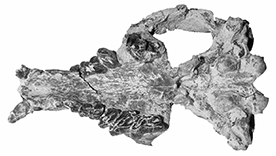
Descargas
Publicado
Número
Sección
Licencia
Derechos de autor 2019 Publicación Electrónica de la Asociación Paleontológica Argentina

Esta obra está bajo una licencia internacional Creative Commons Atribución-SinDerivadas 4.0.

Los/las autores/as conservan los derechos de autor/a y garantizan a la revista el derecho de ser la primera publicación del trabajo licenciado bajo una licencia CC Attribution-NonCommercial 4.0 que permite a otros/as compartir el trabajo con el reconocimiento de la autoría y de la publicación inicial en esta revista.





